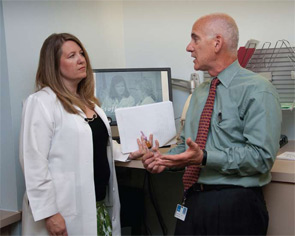Editor’s Note: This is the second in a two-part series about rheumatology health professionals who can help ease the time crunch for busy practices. Part One, about physician assistants, appeared in the June issue, p. 45.
“I am hard-pressed to sit down with a patient and not take extra time to explain a diagnosis or medication,” says Debra Bancroft Rizzo, MSN, FNP-C. Rizzo, who’s been an NP with the Rheumatic Disease Center in Glendale, Wis., for more than 15 years, is voicing one way her practice can enhance the total patient care experience.1 But educating patients about disease management is only one facet of what nurse practitioners (NPs) bring to the rheumatology practice, she notes. “We increase value by bringing in direct revenue as well as increasing patient satisfaction.”
In academic and community practices, as well as Veterans Affairs–run clinics, NPs manage research studies, see new and returning patients, perform joint aspirations and injections, prescribe and monitor medications, and interface with other members of the multidisciplinary team. Rizzo’s primary role has been to evaluate and treat patients, but she has also overseen the infusion department and helped with clinical trials. She is one of five NPs who recently discussed their evolving roles with their physician partners with The Rheumatologist.
Rheumatology NPs have had a role in rheumatology settings since 1976, when Sharon Clark began participating in rheumatology clinical trials at Oregon Health Sciences University.2 Increasingly, certain rheumatology health professionals—NPs and physician assistants (PAs)—are being used to help fill the gap between demand for and supply of rheumatologists. A recent survey on Utilization of Nurse Practitioners and Physician Assistants in Pediatric Rheumatology conducted by Karen L. Kerr, MSN, NP, CPNP, PNP-BC, a pediatric NP with the Division of Rheumatology at Children’s Hospital of Michigan in Detroit; and Andrew Lasky, MD, and NP Kathy Mahoney, RN, APRN, from the Division of Pediatric Rheumatology at Children’s Mercy Hospital in Kansas City, Mo., found that pediatric rheumatologists who used NPs or PAs in their practices found it to be a positive experience.3 The majority would recommend this model to other rheumatologists.
High Expertise

Karen Huisinga, MN, ARNP, FNP, first started working at the Seattle division of the VA Puget Sound 27 years ago. Her NP supervisor had worked in rheumatology for 20 years, and when she moved to another position, Huisinga stepped into her spot. “I have a brother with psoriatic arthritis, so I already had a high interest in rheumatology,” she explains.
Huisinga’s career as a rheumatology NP has coincided with the sea change in management of patients with rheumatic diseases. “In the 90s, when we had little to offer patients besides gold shots, prednisone, and methotrexate, they just came to see me for their maintenance labs. Now, the clinics have become much more of a place where people actually look to us for help and hope, because our goal is remission.” The dynamics of her patient population have also shifted. “We have a lot more young women coming out of the theater, and as a result, we have had expansion of numbers of lupus and RA patients.” As the field of rheumatology and treatments evolved, so have her roles as an NP specializing in rheumatology. That evolution, she says, has been key to the sustainability of her role. “I don’t think I would have stayed had not my role expanded,” she asserts.
Huisinga independently sees patients and, on some days, conducts clinic as the sole rheumatology provider working full-time in rheumatology, four days a week, 10 hours a day. As an NP with a family nurse-practitioner background, she draws on the full range of her capabilities to help her complex VA rheumatology patients. “I deal with their diabetes, congestive heart failure, and other mitigating factors when I’m prescribing rheumatology treatments. I am comfortable in my independent role because I know that I can page my boss at any time. He has been a great mentor. Usually, the cases I run by him are very complicated patients, such as those with mixed connective tissue disease, or complicated lupus or vasculitis.” She has also acquired a reputation as a procedural whiz: “I’ve taught many a resident and doctor how to do aspirations and injections,” she laughs.
Gordon Starkebaum, MD, chief of the rheumatology division at the VA Puget Sound, has worked with Huisinga for over 20 years. His advice to his rheumatology colleagues about incorporating a NP in the practice: “You have to choose a good person and expect that there will be some learning at the beginning.” Then, be prepared to broaden the scope of NP responsibilities, he says, “because anybody worth their salt would become bored with seeing only patients with osteoarthritis of the knee.” Rheumatologists and their NPs must also develop trust, he says, which is key to appropriate patient management, especially in a busy rheumatology service. (At the VA Puget Sound, they see 6,500 patients a year.) “Nurse practitioners have high expertise, but they are not physicians,” says Dr. Starkebaum. “As long as the NP understands that some problems are best handled by consulting with a partnering physician, then you have a very good situation.”

A Research Role
Rheumatology NPs also participate in research. Joyce P. Carlone, MN, RN, FNP-BC, CCRC, is an adjunct faculty member at Emory University’s Nell Hodgson School of Nursing in Atlanta, where she gives rheumatic disease lectures to NP and nurse midwife students. As a certified clinical research coordinator, she also currently manages five active studies. With her partnering rheumatologist, Doyt L. Conn, MD, she has been instrumental in organizing their institution’s participation in the Consortium for the Longitudinal Evaluation of African-Americans with Early Rheumatoid Arthritis (CLEAR) Registry, the largest study of African-Americans with RA.4
Working in Atlanta’s inner-city Grady Hospital, Carlone’s duties are in constant flux. Credentialed by the hospital as a provider, she can also “jump in and see patients,” she notes. Dwindling budgets result in “little social work support,” she says, so on a recent afternoon she was helping a functionally illiterate patient to fill out forms. Connection to her low-income patient population has led to her launching a health literacy study. She has also, since her first attendance at an ACR/ARHP meeting in 1999 (when she joined the rheumatology division at Emory University), been active on the annual meeting planning committee and works to educate other departments and specialties about appropriate referral to the rheumatology service.
Double Learning Curve
Rheumatology has become an outpatient specialty, so exposure to rheumatology during registered nurses’ largely hospital-based training is often minimal. NP training is usually primary-or acute-care based, with limited exposure to rheumatology specific practice. Most of the NPs with whom we spoke acquired their rheumatology training on the job, receiving didactic training from supervising physicians, just as fellows do. Attending the ACR/ARHP Annual Scientific Meetings, taking premeeting courses, and pursuing additional readings all add to their knowledge base. Huisinga was well supported, she says, by the VA in her educational efforts.
During the recent meeting of the ACR’s Pediatric Rheumatology Symposium, Karen Kerr and Dr. Lasky facilitated roundtable discussions regarding the incorporation of NPs and PAs into rheumatology practices. “I think most rheumatologists and rheumatology NPs would agree that a new NP without prior training in rheumatology would need between six months and a year to acquire the competency and skills for seeing patients independently,” reported Kerr.
But acquiring expertise in rheumatology comprises only learning curve number one.
NPs—and their practices—may also go through a second learning curve if the physician has never worked with an NP before. Rizzo, who was hired as part of a research grant in 1996 by her group practice, says that “everything was new” to the physicians as well. The first year or so consisted of a “give-and-take” process she says. “They wanted to see what I could do, and I wanted to see how much independence I could earn.” The year and a half grant period gave her time to prove that she could be a revenue generator and could collaboratively manage patients. NPs can diagnose and treat patients independently; however, in a subspecialty such as rheumatology, NPs may collaborate with physicians on a more regular basis. “I would never think of myself as a rheumatologist,” says Rizzo. “Quite often, I verify things with the rheumatologist, just to be sure I’m on the right track.”
You have to choose a good person and expect that there will be some learning at the beginning. Then, be prepared to broaden the scope of NP responsibilities because anybody worth their salt would become bored with seeing only patients with osteoarthritis of the knee.
—Gordon Starkebaum, MD
Scope of Practice
NPs follow a different educational course from PAs. Typically, they must be a graduate with a master’s degree or higher, and complete NP requirements while holding an active and unrestricted registered-nurse license. Many states require NPs to pass a certifying test administered by the American Nurses Credentialing Center, the American Academy of Nurse Practitioners, the Pediatric Nursing Certification Board, or the National Certification Corporation. There are multiple designations and certifications depending on the level of education completed by the NP. A new advanced-practice registered-nurse regulatory model has been proposed by the National Council of State Boards of Nursing and the American Association of Colleges of Nurses that will require, by 2015 that the entry level for all NPs will be a doctorate degree. (For more information, go to www.ncsbn.org/aprn.htm.)
Kori Dewing, DNP, ARNP, works at the Virginia Mason Rheumatology Clinic in Seattle, has been active in the ARHP, and is an instructor at the University of Washington School of Nursing. In her previous job, she was one of four NPs who saw all new patients for initial workups. The sole rheumatologist refined the diagnoses and developed plans of care, which would be managed by the NPs over time. In her current position, she is much more autonomous, with the ability to see new patients with urgent needs and provide ongoing management of established patients. She also has a special interest in osteoporosis, does injection teaching, and serves as a sub-investigator in clinical trials. Even with all those duties, however, she says that she does have more time with her patients than her physician colleagues do. “My focus tends to be on maintaining wellness and teaching patients what they can do to improve their overall health and achieve their best level of function possible,” she says.
I think most rheumatologists and rheumatology NPs would agree that a new NP without prior training in rheumatology would need between six months and a year to acquire the competency and skills for seeing patients independently.
—Karen L. Kerr, MSN, NP, CPNP, PNP-BC
Increase the Numbers?
Studies have validated the value of using NPs and PAs in the rheumatology practice. Nevertheless, Huisinga still detects a bit of “stigma” and misunderstanding about NPs as fully capable providers, even in the VA system, where NPs are widely used. Some of the confusion, she believes, relates to licensure issues and some is related to physician preferences. Dewing believes that, compared with the level of understanding she experienced at her first ACR/ARHP Annual Scientific Meeting nine years ago, there is now more clarity about the role of NPs. She says that physicians can help educate about the NP’s role by appropriate introduction to the practice. (See “Hiring a Nurse Practitioner? Consider This,” above right, for more on introducing an NP into your practice.)
One thing is abidingly clear: following the workforce study commissioned by the ACR, the College supports increasing the numbers of health professionals to help fill the gap between the number of available rheumatologists and the number necessary to meet patient needs.5,6 That may be easier said than done.
According to a recent study, in addition to the current physician shortage, the United States will also experience a shortfall in the numbers of advanced practice nurses and physician assistants.7 As an adjunct faculty member at the Wayne State University College of Nursing, Kerr believes that NPs have a role to play in attracting more NPs to the field. She regularly precepts pediatric NP students and gives lectures on pediatric rheumatic diseases. She also speaks at local and national NP and PA conferences on topics related to pediatric rheumatology. “It’s important for rheumatology nurse practitioners to mentor other nurse practitioners and physician assistants,” she asserts, “to increase awareness of the rheumatic diseases and convey how rewarding a career in rheumatology can be for them.” the rheumatologist
Gretchen Henkel is a medical journalist based in California.
References
- Hing E, Hooker RS, Ashman JJ. Primary health care in community health centers and comparison with office-based practice. J Community Health. 2011; 36:406-413.
- Hooker RS. The extension of rheumatology services with physician assistants and nurse practitioners. Best Pract Res Clin Rheumatol. 2008; 22(3): 523-533.
- Kerr K, Lasky A, Mahoney, K. Utilization of nurse practitioners and physician assistants in pediatric rheumatology. Abstract presented at the American College of Rheumatology Pediatric Rheumatology Symposium, June 2011: Miami, FL.
- Bridges SL, Causey ZL, Burgos PI, et al. Radiographic severity of rheumatoid arthritis in African-Americans: Results from the CLEAR Registry. Arthritis Care Res. 2010;62:624-631.
- Deal CL, Hooker R, Harrington T, et al. The United States rheumatology workforce. Arthritis Rheum. 2007;56:722-729.
- Birnbaum N. American College of Rheumatology Response to the 2006 Rheumatology Workforce Study. Arthritis Rheum. 2007;56:730-731.
- Sargen M, Hooker RS, Cooper RA. Gaps in the supply of physicians, advance practice nurses and physician assistants. J Am Coll Surg. 2011; 212:991-999.
Hiring a Nurse Practitioner? Consider This
Studies have shown that adding a NP to the practice is often revenue positive and increases patient satisfaction. According to sources interviewed by The Rheumatologist, the following considerations can help physicians assess whether and how to employ a NP.
Consider what you want to achieve by adding this additional health professional to your practice. Do you envision the NP seeing all new patients and doing the initial workups before you see them? Or, do you want the NP to mostly see return patients, or those with certain clusters of diagnoses?
- Research the licensure requirements in your state regarding prescription privileges, physician supervision versus independent practice, and third-party billing for the NP. The website of the National Council of the State Boards of Nursing (www.ncsbn.org) can provide state-by-state information.
- Prepare to invest the time and money to bring the NP up to speed in rheumatology. Can you send the NP to the ACR/ARHP annual meeting, for instance? Financing their participation in the ACR Advanced Rheumatology course will guarantee that your NP acquires a standard amount of information.
- Think about the progression of functions you will be able to offer the NP, keeping in mind that after the initial orientation and learning curve, the NP may be able to expand into a variety of functions. This will help your candidate gauge whether he or she can remain engaged and challenged as a rheumatology health professional.
- Be prepared to review the NP’s notes and give constructive feedback. An example might be, “Here was a complex disease where I would have liked to have been involved sooner. This test was omitted and this lab result was not interpreted correctly. Let’s be sure to talk about these in the future.”
- Welcome the NP to the practice and educate the front office staff about the NP’s functions. Consider sending a welcome letter introducing the NP to patients and referring physicians.
Sources: Joyce Carlone, Karen Kerr, Karen Huisinga, Gordon Starkebaum, Kori Dewing

